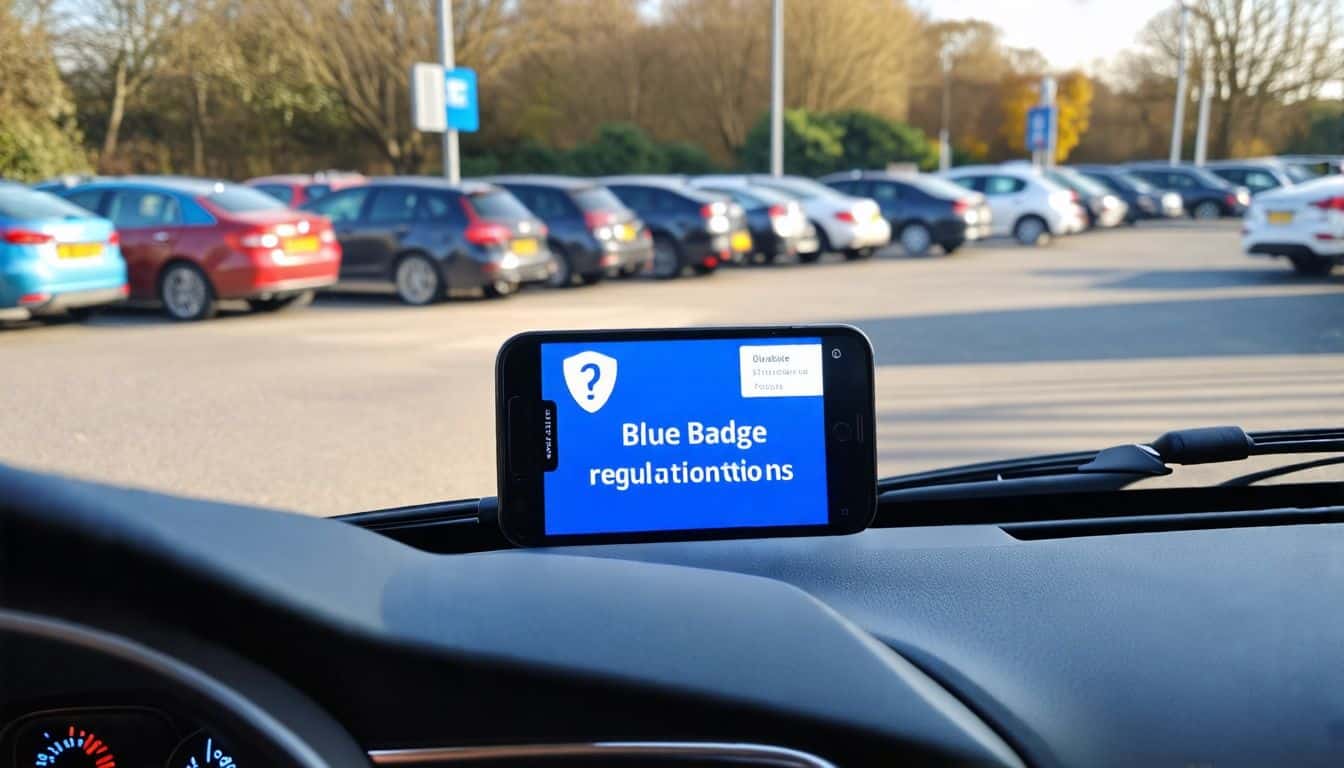Blue Badge Display Rules: Ensure Proper Use & Avoid Penalties
Are you confused about Blue Badge display rules and regulations? Many drivers with disabilities struggle to use their badges correctly. Blue Badges help people with mobility issues park closer to their destinations.
This guide will explain how to display your badge properly and avoid fines. Learn the dos and don’ts of Blue Badge use today.
Responsibilities of Blue Badge Holders

Blue Badge holders must follow strict rules. They need to know how to use their badge and when to tell officials about changes.
Correct display of the badge
Badge holders must show their Blue Badge the right way. Put it on the dashboard or fascia of your car. Make sure the front faces up. People should see the hologram easily. Keep the badge in good shape.
Check it often for damage. A badge that’s hard to read might get you a fine.
Use your parking clock when needed. This clock comes with your badge. Set it to show when you arrived. Put it next to your badge. Don’t forget to do this in pay-and-display areas. Traffic wardens look for both the badge and clock.
Follow these rules to avoid penalties and use your badge properly.
Reporting changes in circumstances
Blue Badge holders must tell the council about any changes. This includes a new address or a different car. It’s vital to report if the badge is lost, stolen, or damaged. The Driver and Vehicle Licensing Agency needs to know if your health gets better.
Quick action helps keep your badge valid and avoids fines.
You can update your details online or by phone. Some councils let you do this through their website. Others may ask you to fill out a form. Always keep your contact info up to date.
This ensures you get important notices about your badge. It also helps if you need to renew it later.
Where You Can and Cannot Park with a Blue Badge
Blue Badge holders enjoy special parking rights. They can park in many places others can’t, but some rules still apply.
Permitted locations and restrictions
Blue Badge holders can park in many places. But they must follow some rules to avoid fines.
- On-street parking: Badge holders can park for free on single or double yellow lines for up to 3 hours. They must show their badge and parking clock.
- Pay and display: Badge holders can park for free in most pay and display bays. They don’t need to use the parking meter.
- Disabled parking bays: These spots are for Blue Badge holders. Some have time limits, so check signs carefully.
- Car parks: Many car parks offer free parking for badge holders. Always check the rules at each car park.
- Red routes: Badge holders can stop to drop off or pick up people. But they can’t park on red lines.
- Pedestrian zones: Badge holders can usually enter these areas. They must follow any time limits shown on signs.
- Private roads: Badge holders need permission to park on private land. This includes hospital grounds and supermarket car parks.
- Bus lanes: Badge holders can’t park in bus lanes during their hours of operation.
- Cycle lanes: It’s not allowed to park in cycle lanes marked by a solid white line.
Next, we’ll look at the special rules for central London.
Special rules for central London
Central London has special rules for Blue Badge holders. These rules apply in certain areas like Westminster and parts of Kensington. Badge holders can’t park on red lines or in resident bays here.
They must use pay-and-display bays or disabled bays instead. The London congestion charge still applies to Blue Badge holders in these areas.
Drivers should check local signs carefully before parking. Some streets may have extra limits on Blue Badge use. It’s best to plan trips and check rules before going to central London.
Next, we’ll look at what happens if someone misuses their Blue Badge.
Consequences of Misusing a Blue Badge
Misusing a Blue Badge can lead to serious trouble. You might face fines or even lose your badge if you break the rules. Local councils keep a close eye on Blue Badge use. They can take action if they spot any fraud or forgery.
Penalties and legal implications
Misusing a Blue Badge can lead to big trouble. Drivers may face fines and legal action if they break the rules. Local councils can give out penalty charge notices for wrong use. These fines can be costly.
In serious cases, the police might get involved. They can take away the badge and even press fraud charges.
Blue Badge holders must follow the rules of the road. They can still get fines for parking in the wrong spots. It’s vital to display the badge clearly. The front should face up, showing the hologram.
Keeping the badge in good shape is key. Drivers should check it often to avoid problems with parking wardens.
Conclusion
Blue Badge holders must follow the rules to avoid fines. Proper display and use of the badge is key. Always keep your badge in good shape and visible. Know where you can park and follow local laws.
By using your Blue Badge right, you help keep parking fair for all.
FAQs
1. Where can I display my Blue Badge in my car?
Put your Blue Badge on the facia or dashboard. Make sure people can see it from outside. This helps avoid fines when you park in special spaces.
2. Can I use my Blue Badge at parking meters and in carparks?
Yes, you can use your Blue Badge at parking meters and in carparks. But check local rules first. Some areas may have different rules for Blue Badge holders.
3. Are there places where I can’t park with a Blue Badge?
You can’t park on cycle tracks, at pedestrian crossings, or in some parking spaces. Always look for signs that show where you can and can’t park.
4. What should I do if I have a complaint about Blue Badge parking?
If you have a problem, talk to your local government. If that doesn’t work, you can contact the local government ombudsman. They can help with complaints about Blue Badge issues.
5. How can I renew my Blue Badge?
To renew your Blue Badge, contact the Driver and Vehicle Licensing Agency (DVLA). You may need to fill out forms and pay with a credit card. Make sure to do this before your current badge runs out.

